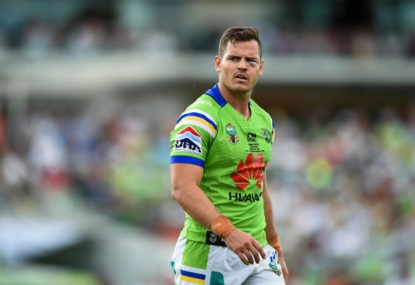Five and a kick: Benji's Tigers lost to Penrith, but did they actually win in the long run?
1. Tigers earning their stripes The Tigers played Souths last year when the Bunnies were at their very highest point. Tim Sheens coached them…

Congratulations to the Canberra Raiders! With all other remaining teams either too decorated or insufferable, they are officially the fairytale-elect of the 2016 title race. (Click to Tweet)
Unless you’re holding a grudge against Ricky Stuart – in which case you’re probably just an Eels fan or a plastic chair – then you’re probably one of the neutrals, like me, who has affiliated with the Green Machine in a landslide.
But what really is our hollow, transitory support in aid of? What do we really know about the club’s backstory?
For those who weren’t sucking their thumbs through the late 1990s, and anyone who doesn’t believe Woodgers to be a rare species of tree-based mammal, you’ll be conversant of the Raiders’ history, along with the club’s tormented gang of frost-bitten rusted-ons.
But if you’re a Gen-Y trendoid, a rotten faddist who has leeched to the side of the bandwagon, or even one of those Melbourne fans who are AFL followers without a game to attend, you’d be forgiven for thinking they’re just a pack of perennial tenth-placed schlubs who are magically over-achieving.
But you’d be wrong. Partially.
A nutshell history
The Raiders were established in 1982 by a cash-strapped NSWRL in search of a strategic outpost near the Royal Australian Mint. The club initially set up camp at Seiffert Oval, but were eventually forced to move after most of the venue’s equipment was vandalised by Mal Meninga’s ulna.
After a backbreaking five-year drought, Wayne Bennett and Don Furner guided the team to the playoffs in 1987. Here they qualified for their maiden grand final, and you can assume the result of the match by use of the word ‘qualified’.
Following this breakthrough season, the Queensland mastermind pledged to oversee long-term success at Canberra. He was true to his word, and he hung around almost eight weeks before defecting to the Broncos.
Amazingly, Bennett’s departure did not leave the playing list in utter disarray. Even more amazingly, Raiders administration managed to attract more blue-chip talent to Canberra without the need to offer up the title deeds to Parliament House.
What resulted was a golden era of three premierships in six seasons and the birth of some of the future’s most strung-out coaches.
1997 saw a tumultuous period for the Raiders, when they defected to the breakaway Super League competition. This brought the club into line with other major industry in the Canberra region that was already following the instructions of Rupert Murdoch.
The Raiders lurched to years of mid-table mediocrity following this period of great upheaval. This was only interrupted by the blip of 2003 when the madcap Matt Elliott coached the club to an unexpected top-four finish.
Despite entering the finals with expectations high, they were sadly bundled out in the second week with a 17-16 loss to the Warriors. Unimaginably, it was Jason Bulgarelli who spilled the match-winning try, a player best known for specialising in possession.
This triggered major disappointment in the region and it plummeted to the lowest footballer-per-capita rate in the country, with statisticians estimating numbers at 500,000 people per Alan Tongue.
As the club faded as an on-field force, it earned notoriety for its nepotism, repelling of talent, and gross exploitation of Shaun Fensom.
But despite returns on the field repeatedly failing to meet expectations, Canberra did grow into one of the richest backline talent nurseries in the game. This was evidenced by the plethora of fine personnel the organisation routinely produced for all clubs but itself.
Unfortunately, the only time the Raiders saw these point-scoring superstars was in courtroom sketches, and as they left town for better nightclubs, the team evolved into a hulking, intimidating forward pack that dominated in front of a group of backs eating paste.
Theories abounded as to the club’s deteriorating culture. Some analysts believed it to be the unappealing location and climate, while some others speculated they were closet vegans.
Whatever it was, club bosses took action to cajole the organisation from its slumber by hiring an overhead-projecting reverse-psychologist who knew the club better than anyone before him. Which was saying something, because the last bloke was the boss’ brother.
That man is Ricky Stuart, bringing us to the present day of 2016 where the Raiders break their premiership drought.
I can write that, as he has promised it will happen. And he’s never been wrong.
Oh yeah, except for the Parramatta thing.